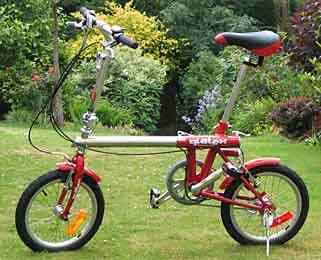
I was contacted by the UK distributor of the Giatex in mid-June 2004, supplying me with some information on this bike, and asking me if I would like to borrow one to test it. Naturally I accepted the offer, so here, based on about a week's experience, is the report.
As the name suggests, the bike compresses/stretches by means of a telescopic main frame member, reducing the length, and also giving a means of adjusting the reach from saddle to handlebars to suit the rider. The handlebars also fold down, and the seatpost is retracted – more on 'folding' later.
The bike is aimed mainly at the Recreational Market: - Boating, Caravanning, Flying etc.
The bike arrived very promptly, safely packed in its padded bag inside a cardboard box.

The Giatex as I rode it - frame fully extended to give maximum reach (and stability), seat post near the top of its advised travel, and handlebars as low as possible. The very short mudguards are not likely to be of much use, but the prop-stand can be useful, not least when taking photographs!
The sample supplied was finished in a bright red colour – black, silver and dark green are the other available colours. The colour applies to the rear frame and forks – the telescoping section of the frame and the handlebar stem are a silvery anodised aluminium colour. The coloured parts, and the main upright section of the steerer/stem are steel, the rest of the bike being an aluminium alloy. The bike came fully equipped with reflectors and a prop-stand. Overall, the appearance is quite smart and the finish seems good, and although the wheels are very small, the bike looks quite balanced. The bike attracted favourable comments, based on its appearance, from non-cyclists who saw it.
The wheels/tyres are 16 inch x 1.75, the 305 size which is NOT the same size as used by Brompton, Airframe, Micro etc. This is a substantially smaller diameter wheel, and one which seems more prevalent in North America, and less popular here in the UK. Tyres for wheels of this size are typically much wider and much lower pressure than is the case for the 16 inch 349 ones with which we are more familiar here. In the case of the Giatex, the 16 x 1.75 inch tyres have a substantial amount of tread and are rated at a mere 40psi (compared with around 100psi on many of the narrower 349 tyres). This is likely to result in significantly greater rolling resistance, though on the road (see later) this was not quite as much of a problem as I had feared. The width and high profile of the tyres serves to some extent to compensate for the small wheel size, though the overall diameter is still smaller than the 349-sized wheels and tyres. Schraeder-valved tubes are fitted – although I normally have a preference for Presta valves on bicycle tyres, the use of the Schraeder is probably sensible given the low pressures and the intended market.
Tiny (metal) mudguards, finished in the frame colour, are fitted. They are so small that it is difficult to believe that they will provide any benefit, and no stays are required. However, quite surprisingly, there are mountings on both the front and rear forks for attaching mudguard stays, so if you can find some longer mudguards which will fit, there should be a means of attaching them. Additional mountings on the rear seem possibly intended for a carrier, though actually there is provision for a special carrier, as mentioned below. An additional bracket on the left-hand rear fork looks as though it might be intended for a dynamo, though it looks a bit far from the rim. The main rear frame member actually passes to one side of the seat tube (as of course it has to do with the telescoping action), so that when riding the main frame tube is not in line with the wheels – slightly disconcerting if you look down, and it also makes lining up the handlebars and saddle a bit awkward, but of no consequence otherwise. A short tube is attached to the seat tube, projecting backwards, and with a plastic end cap (with a retaining ring, so that it won't be lost when removed). This is intended for mounting the special optional rear carrier – rather like the system used on the original Moulton Stowaway. No carrier was supplied with the test bike – the pictures suggest it is fairly small.
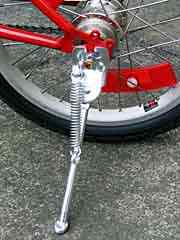
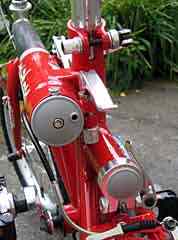
Above Left: The prop-stand. Above centre: the end of the telescoping main tube, and below it, the tube into which the optional rack would plug, secured and released by a quick-release clamp. Above right: Another view showing most of the quick-release clamps - two to secure the main frame tube (the tube is keyed to that it will only slide, not rotate), one for the seat pillar and one to secure the rear carrier, if fitted.
The components fitted are basic, but look quite robust.
Folding pedals are fitted - see the next section for more details.
The handlebars are adjustable for height, although this seems to err on the side of providing for the bars to be set much higher than many regular cyclists would choose. Saddle height is adjustable through quite a large range as well, but, although I am only 1.7m (5'6.5”, 65.5"), with quite short legs, I needed the saddle quite near to its uppermost position – only about 1 inch more travel available before the warning marker on the seatpost is reached. Many people of course ride with the saddle way below its optimum height, but if you do like the saddle at the correct height, then you probably will have problems achieving this if you are tall. I set the handlebars at their minimum height, and they were still a little higher than I would ideally like. I also fully extended the horizontal frame member when riding, which gave a comfortable reach – although it can be set to almost any intermediate extension, only those who like a short reach are likely to want to reduce the extension much, and as this shortens the wheelbase, it may also have a detrimental effect on handling and ride. The suppliers report that a number of six footers have found the riding position quite satisfactory.
A very soft saddle is fitted - it helps to insulate the rider from the road surface, quite important with such small wheels, but like all such saddles is not very comfortable for rides of over 10Km. I usually change the saddle on bikes, but as I was only testing the bike for a short period, and did not plan any long rides, I retained the standard saddle for the duration of the test.
A brief multi-lingual instruction book came with the bike, with an addition booklet on the Sturmey-Archer hub.
I've already made some reference to how the bike is folded/compressed. It is one of the simplest, most foolproof, processes I have come across, and really it is impossible to get in a mess in doing it, with a couple of provisos that I'll come to in a moment. Essentially, all you need to do to compress the bike is release two substantial quick-release (QR) levers near the back of the frame, and then slide the telescopic front section back towards the seat as far as it will go, and do up the QR levers again; release another QR lever on the base of the stem, and fold the handlebars down; finally, one more QR lever releases the seat post and you lower it as far as it will go. The pedals can be folded - they lock positively into position in both the folded and unfolded positions, and look quite well made, although the plastic pedalling surface was slightly slippery when wet. Once folded, the bike can then be picked up and carried by the saddle or the main frame member. It's a quick and simple process, and the bike does not show any inclination to come apart when compressed (though the handlebars are not actually secured in the folded down position). Unfolding is almost as straightforward – release the seat QR and extend the seat post – it will be useful to mark the required height on the post, and of course it also needs to be aligned with the direction of travel, which is not quite the same as the main frame member. The two Q-R levers securing the telescopic section of the frame are then released and the front pulled forward – it is keyed so that it will not rotate as you do this; if you don't use the fully extended position, a mark on the frame will also help to position it at the required extension. Closing the QRs to secure the frame does require slightly more thought, though it should be pretty obvious that they need to be positioned with the levers in line with the frame, otherwise they will get in the way when riding (there is nothing physically to stop incorrect positioning of the levers). The handlebar stem is then folded out and the catch is pushed into position. Personally I thought the plastic retainer for the lever looked rather flimsy, and I actually wrapped a toeclip strap around the lever to be on the safe side, but I am probably just being over cautious - the suppliers report that it has passed extensive tests. Finally it is just a case of unfolding the pedals.
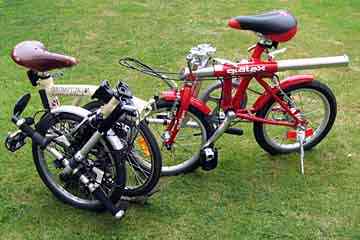
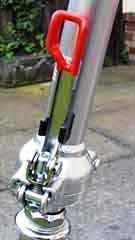
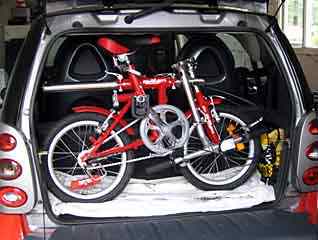
Above left: The bike in its folded form, with a Brompton (well, actually it is an SP version, but the same as a normal Brompton in terms of folded size) for comparison. The Giatex is considerably longer, a little taller, and a fraction narrower. Above centre: The steerer/handlebar fixing clamp. Above right: The Giatex easily passed the "Smart test"; it was necessary to fold the top of the cover of the luggage space down, but the rear part could be left in place. The Giatex fits almost exactly into the space in terms of length and height, and was a comfortable fit in terms of width, even with the back cover of the luggage space still in place. Rearward vision is somewhat impeded, though removing, rather than retracting, the seat post would overcome this, and also make it a slightly less tight fit in terms of height.
The chain is of course left exposed on the side of the bike when it is compressed, but it is easy to avoid it, and its very short length reduces the risk of getting dirty. Plastic chain covers are fitted on both sides of the chainring, providing further protection when the bike is folded, or being ridden.
The bike came with the optional extra carrying bag. This is a very substantial padded bag, and should provide very good protection for the bike when it is being transported, or protection for any vehicle in which it is being carried. Putting the bike in the bag makes it look much bigger than when left folded but uncovered. The major down side of the bag is that it is totally unsuited to commuting - it is very heavy at around 2-3Kg, and it would be difficult to fold or roll up and then carry on the bike. I would suggest that unless you need the protection this bag provides, a drop-over cover would be far more appropriate. The bike is quite neat anyway when folded, though not especially compact (see photograph above), so although I did not test the reaction of bus and Metro drivers, in most situations it would probably not be necessary to cover it when commuting by train.
The basic fold produces a reasonably compact package - larger of course than a folded Brompton, but smaller than some. By taking advantage of the prop-stand, it is stable in the upright position when folded, but is also easy to lean against a suitable upright surface. This is a fairly heavy bike - somewhere around 26 pounds. I would not want to have to carry it far, but given the ease of folding, or partially folding/unfolding, you would normally roll it along on its wheels until the last moment. I don't quote folding times, as it depends so much on familiarity, but the simplicity of the operation makes for quite a quick fold - certainly it should be under half a minute (excluding bagging, and removal of any luggage).
The bike is fitted with a Sun Race Sturmey-Archer 3-speed hub gear, giving the usual combination of direct drive in the middle gear, and 25% reduction and 33% increase in the other gears. With a 16 tooth sprocket and 48 tooth chainring, and the small 16 x 1.75 tyres, this results in gears of 33.5, 44.7 and 59.5 inches. This is a very low range – I much prefer to err on the side of low rather than high gearing, but nevertheless theory suggests that I would actually be inclined to go a bit higher than this – a 15-tooth sprocket would give 35.7, 47.7 and 63.5 inches, which is still quite low. Please see the later comments on using the bike for some further thoughts on this subject. The Sturmey-Archer hub is not greatly changed in its current Taiwanese incarnation, at least from the user's point of view. The actuation on the hub is quite well protected on the Giatex, with a plastic cover around the actuation rod and chain where it exits from the end of the axle (which means that you cannot see to follow the approved method of adjusting the gears) and a metal protection cage below the gear to protect from any knocks – rather an overkill I would have thought for a bike which is hardly likely to be used for serious off-road riding. Adjustment is achieved by the usual collar connecting the cable to the actuation chain, but also by means of a sleeve where the cable outer is mounted via a bracket to the forks. There is no adjustment available on the handlebar twist grip. The twist grip itself operates positively, and has a clear indicator to confirm which gear has been selected.
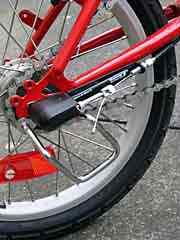
Good protection for the gear change mechanism on the hub
The choice of this simple, trouble-free hub gear is quite appropriate to this type of bike, and is favoured by many other folder manufacturers. Regular readers will know that personally I dislike the wide gaps between the gears on 3-speed S-A and Sachs/SRAM hubs. With only 3 gears available, I suppose this arrangement is difficult to avoid if a reasonable range is to be provided, but I still found the gaps as uncomfortable as always. However, I did not suffer the problems with my knees that I usually get if I ever ride a bike with these gears - perhaps to some extent a result of the low gearing.
Alhonga V-brakes are fitted, with good levers which give quite adequate stopping power, and reasonably good feedback. With the fairly substantial tyres, there is not much risk of accidentally locking a brake. On the test bike, the brakes were set up for right hand operation of the rear brake, and left hand operation of the front brake – the opposite of what is usual in the UK (but normal in the USA), but I understand that will be changed on the bikes supplied here in the UK in future. I simply removed the grips and swapped the levers over – slightly untidy, as the brake securing bolt was visible from above, but a simple solution and one which could be reversed easily when the bike is returned. The brakes were set a little tight, and the springs of the V-brakes needed slight adjustment to centre them – very minor adjustments and not a serious issue.
As I've said repeatedly before, the market for folders is very diverse, with an enormous range from ultra-compact and light commuting folders to high-performance road bikes which can be folded. There are always compromises of weight, ease of folding, performance, price etc to be made, and there is no single folder that can, or ever will, be perfect for every potential user. So in evaluating any folder I try to make the test and the report relevant to the type of user for whom the bike is most appropriate. In the case of the Giatex, this is clearly not a high-performance folder for tackling Audaxes or doing long distance tours with camping gear! It is obviously intended primarily for commuting, boat owners, light recreation etc, and I've evaluated it primarily with this in mind, although inevitably the use I make of a bike does test it beyond what most of the intended buyers will subject it to.
During the week I had the bike, I used it to visit the Local Bike Shop, which is not so local at 10Km from where I live, using a hilly road to get there, and the canal towpath for the return. I also did my early morning short exercise ride (3KM) on it a couple of times, went to the pillar box on it, and used it for the train-assisted commute to the university once - a ride which turned out to be more testing than intended, as I'll explain in a moment.
On all these rides I only used bottom gear once - on a steep climb locally on my way up to Sedgely when visiting the LBS at Wolverhampton. I certainly needed the low gear for that climb, but overall this confirmed my view that higher gearing would be preferable, especially as almost any downhill gradient, unless riding into the wind, reduced me to coasting, as I simply could not pedal fast enough in top gear to build up much speed. The low gearing means that it is best simply to plug along at whatever speed you can maintain, and not try to hurry. On the descent from Sedgely on the way to Wolverhampton, this was quite relaxing, but in some other situations it did become frustrating. The combination of an ascent, where the rider has to work hard anyway, followed by a descent where I was coasting most of the way, served to mask any problems of high rolling resistance of the rather fat tyres. The return route was via a canal towpath from Wolverhampton to Tipton - dry, with a hard surface, but not tarmaced for most of the way. On parts which did have a good concrete or other hard surface, the bike bowled along quite well, and was not uncomfortable despite the small wheels - the fairly fat, low-pressure tyres, and a soft saddle, provided quite good insulation. However, on some rougher concrete sections, where the surface had broken up badly, the ride was painful (as indeed it is on anything except the fully suspended bikes!). On the sections of the towpath (ie most of it) where the surface was hard earth or a combination of this and pressed-in grit, the ride was good, and the fat tyres gave good grip. The low gearing meant that almost the whole of the towpath (no locks on this section) could be ridden in top gear - another indication of the low gearing. A few overbridges did require a down-change, and a couple with extremely rough approaches persuaded me to dismount (again, I do this on these particular bridges on most of my bikes). Walking through Coseley tunnel was more pleasant than usual - but simply because for once I had remembered to take a lamp! Overall I quite enjoyed this ride.
The short local rides were not really much of a test - the bike performed perfectly adequately, though even on these rides, the low gearing was quite evident - I comfortably climbed in second gear a hill that I would really have expected to need bottom gear for on a 3-speed, but had to proceed relatively slowly on flat sections.
The frame generally felt quite stiff - there was no significant flexing, and the long steerer/handlebar stem was also stiff - only very minimal flexing could be detected even when working quite hard. The saddle was decidedly soft, which, as mentioned, soaked up some road surface irregularities, and was acceptable for short distances. On the longer rides, including the one described below, like all soft saddles it became much less comfortable after about 10Km.
My commute turned out to be something of a test for the bike. My usual routine is 2.5Km to the station, train, and then 4Km from the station to the university; the return journey, in reasonable weather, usually involves a longer ride (for pleasure) to Hampton in Arden, Birmingham International or Marston Green, then the train and the final 2.5Km home, giving a round trip of 24-32Km. On this particular occasion, it turned out that there had been vandalism of the signalling, and the train on the outward journey only went as far as Birmingham International. This was bad news, as early arrival at the university is essential so that I can access the computers for software maintenance before anyone else arrives. A bus was promised from Birmingham International, but was not in evidence, and there is always uncertainty as to whether they will take even the most innocuous of folders. Therefore it was with some trepidation that I set out on the ride from International to the university - it is harder work going this way than the return journey, with the added fact that I really needed to hurry in order to get there early enough to do my work. The Giatex would not have been my choice had I known that I was going to have to do this - the rather fat tyres and the low gearing are not conducive to a ride of about 20Km when in a hurry. I certainly found it quite hard going - bottom gear was never needed, and I really would have liked some higher gearing. Nevertheless, the bike got me there in just over an hour, but I felt far more exhausted than I would have been on, for example, my old T5 Brompton or SP (both of which are of course effectively over double the price of the Giatex). To be fair, I think I was also not at my fittest that day, and a 77Km ride the previous day had left me feeling rather tired. After this rather hectic start to the day, and some uncertainty as to whether the trains would be running normally for my return journey mid-morning, I set out intending to ride from the university to Birmingham International - easier in this direction both because of the prevailing gradient and the lack of any need to hurry. By the time I reached Hampton in Arden, I was feeling a bit weary, and as I was there at precisely the right time for a train, as opposed to having a wait for the next one if I went on to Birmingham International (the next station), I baled out here. Unfortunately it turned out that there was still major disruption to the trains due to the damaged signalling, so I had a longer wait than anticipated. The train, when it arrived, was fairly full, but not to the extent that I needed to 'fold' the bike. Although 'folding' is quite easy and quick, I don't think I would 'fold' it unless I needed to - indeed, I commented to a Brompton owner sitting opposite me that we were demonstrating one of my theories - only Brompton owners seem to fold even when it isn't necessary to do so.
The visit to the LBS, as described above, was about a 20Km round trip. I would suggest that it is rather more than most potential owners would use the bike for, but it performed adequately on road and on the towpath - I imagine the bike might well appeal to boat owners, or people who might do an occasional short recreational ride along a bit of towpath or similarly surfaced cycleway. The low gearing was something of a disadvantage on this particular road ride, but tolerable, and for people using it mainly around town, or for short commutes to or from a station, that is probably tolerable. The less typical, stressful extended commute did test the bike more, and probably beyond the general way the bike would be used by most prospective owners. It did the job for me on this occasion, but not surprisingly it was not as well suited to this as some other, more expensive and higher performance, folders.
"Horses for courses" again - this is quite an attractive looking little bike which 'folds' quite easily, quickly and effectively (though it is not particularly small when compressed), and which performs adequately for short train-assisted commuting and short recreational rides. The small diameter, fat, low-pressure tyres and low gearing make it less suitable for anyone with aspirations for longer rides. Our tests probably went beyond what most purchasers will subject the bike to. However, for what seems to be the intended market - the recreational market, boating, caravanning, flying etc - it is a reasonable performer (though I'd still suggest raising the gearing a fraction), and at £230 (June 2004) it is very reasonably priced - indeed, just for June 2004 there was a special offer in which this price included the bag and rack.
UK Distributors:
Jungle Bikes
PO Box 853
Cheltenham
Glos
Phone/Fax: 01242 573126
Web:
http://www.junglebikes.com
email:
sales@junglebikes.com
Giatex web site: http://www.giatex.com
Folding Society home page | Test reports page
Copyright (C)2004 Ferrets Anonymous
Last updated: 30 June 2004
URL: http://www.foldsoc.co.uk/giatex.html